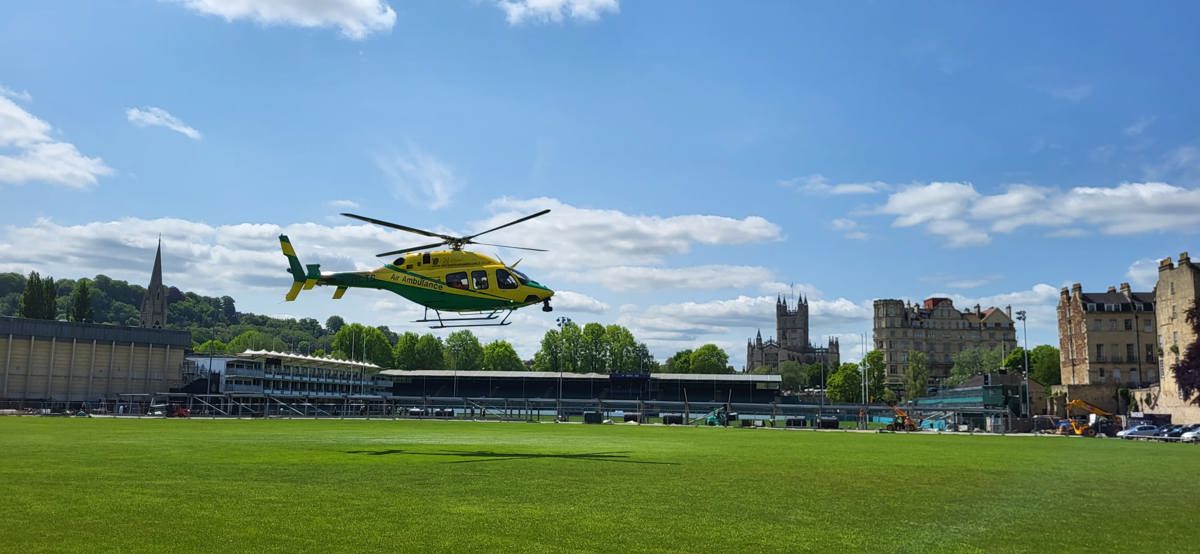Drone safety highlighted
Wednesday, 17 July 2024

After a near-miss earlier this year as our Bell 429 helicopter was lifting from the Recreation Ground, we wanted to remind you about the dangers of flying a drone.
Why can drones be dangerous?
Our air ambulance has been delayed in departing from scene a few times this year due to drones being flown very close to the helicopter.
It was only through the vigilance of the front seat critical care paramedic and the pilot that a collision was avoided.
We want drone users to have fun with their drones but to do so safely and legally.
However, if a drone was to strike a helicopter it is likely to cause significant damage due to the solid metal parts it has and a solid battery.
The last thing we want is for drones to damage our helicopter so we can’t undertake our important lifesaving work.
The law
Whilst small drones (less than 250g) without cameras do not need to be registered, most drone users in the UK are now required by law to register themselves as a drone operator - this currently costs £10.33 per year. Failure to do so could result in a £1,000 fine.
If the drone is heavier than 250g then the individual pilot also needs to register and pass an exam.
The Civil Aviation Authority (CAA) has also published The Drone Code to assist drone users to fly safely.
The code includes not flying drones above 400 feet, always keeping your drone in direct sight and not flying drones near airfields or airbases. Failure to do so could result in criminal prosecution.
Steps you can take to fly your drone safely
A drone is much smaller than a helicopter and it can blend into the background. It’s really important that people who operate drones can see them when they are flying. If they can’t see their drone when it’s flying then they won’t be able to see other aircraft, such as helicopters, flying either.
Due to the nature of our work we often land and take off in residential areas. We spend more time below 400 feet than most other aircraft so this is another important factor for drone users to be aware of.
If you are flying your drone and see our helicopter or any other aircraft, please land your drone and wait for us to land or fly away from your area. When we are at scene, please come and say hello to our pilots rather than using a drone to take a peek.
We are not trying to stop people flying their drones but we want them to do so responsibly and safely.
More information is available online
Head to the CAA website where you can register and download a copy of The Drone Code.
We hope you’re out there enjoying flying your drone, but please do spare a thought for Wiltshire Air Ambulance flying in the skies and help to keep us all safe.
Richard Miller, Wiltshire Air Ambulance’s safety manager, commented: “We want drone users to have fun with their drones but to do so safely and legally.
“However, if a drone was to strike a helicopter it is likely to cause significant damage due to the solid metal parts it has and a solid battery.”
“However, we want drone users to help us to ensure our team and lifesaving operation isn’t put at unnecessary risk.”
Whilst small drones (less than 250g) without cameras do not need to be registered, most drone users in the UK are now required by law to register themselves as a drone operator - this currently costs £10.33 per year. Failure to do so could result in a £1,000 fine.
If the drone is heavier than 250g then the individual pilot also needs to register and pass an exam.
The Civil Aviation Authority (CAA) has also published The Drone Code (available free on their website) to assist drone users to fly safely.
In addition, drone users can use the app Drone Assist to issue and review NOTAMs (notice to airmen), as well as no-fly zone notifications, ground hazards and the latest map data.
“The app is free to download and is a must-have for drone users,” added Mr Miller. “It is billed as the one-stop shop to help drone users pre-plan flights and to operate safely.”
Find out more
View our interactive mission map
Find out how many times our aircrew we have been called to your area.